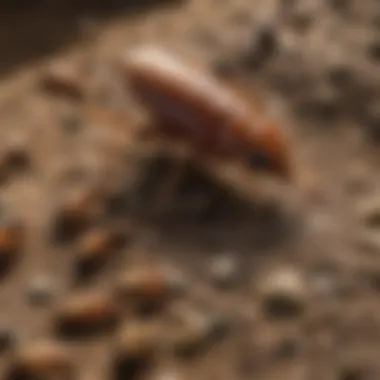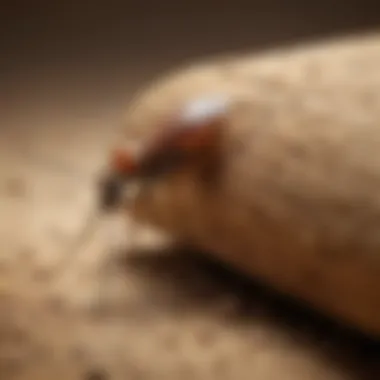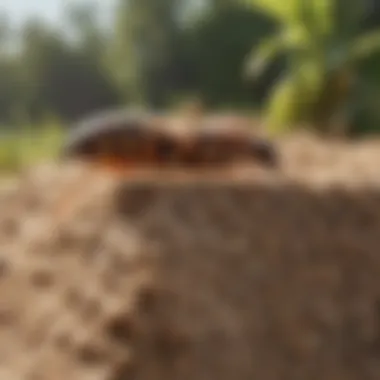Chemical Solutions for Effective Termite Control


Intro
Effective termite control is a pressing concern for homeowners and property managers alike. Termites can cause substantial damage to structures, often going unnoticed until extensive harm is done. This article aims to shed light on the effective chemical solutions used in termite extermination. We will discuss how these chemicals work, the best methods for their application, and essential safety considerations to keep in mind. The discussion will provide a balanced view, focusing on both traditional and eco-friendly treatment options. By understanding these solutions, individuals can make informed choices that suit their needs while being mindful of ecological impacts.
Understanding the Pest
Identification
Identifying termites accurately is crucial for effective control. Termites often resemble ants, but they have distinct features. Termites are generally lighter in color, with straight antennae and a broad waist. They also have two pairs of wings that are equal in size when present. Among the various species, the most common ones found in the U.S. include the Eastern subterranean termite, the Formosan termite, and the drywood termite.
Life Cycle
The life cycle of termites consists of several stages: egg, nymph, and adult. The process begins with the queen laying eggs. Eggs hatch into nymphs which then undergo multiple molts before becoming adults. This cycle can take several months to years, depending on species and environmental conditions. It is essential to understand this cycle as treatments may vary phase to phase. For instance, chemical treatments are most effective when targeting nymphs or immature stages, which are more vulnerable than adult termites.
Pest Prevention Strategies
Environment Modification
One of the first steps in termite control is modifying the environment to make it less hospitable to these pests. Keeping wood piles away from the foundation and ensuring that gutters function properly to divert water away from the home is crucial. Additionally, fixing leaks and reducing moisture in the soil can deter termites from invading your space.
Physical Barriers
Physical barriers can be an effective strategy in preventing termite infestations. Installing metal shields or sand barriers can create obstacles that termites cannot cross. These barriers are particularly useful during the construction of homes, providing a proactive approach to pest management.
Control Methods
Chemical Control
Chemical control remains a predominant method for managing termite populations. Various pesticides, such as fipronil and imidacloprid, are commonly used. These chemicals act by disrupting the termites' nervous systems, ultimately leading to their elimination. The application can include treatments that create a protective barrier in the soil around the structure and direct applications to affected areas.
Always follow manufacturer's instructions when using chemical treatments and consider professional assistance for application.
Biological Control
Biological control represents an alternative approach, focusing on using natural predators or pathogens. For example, nematodes, microscopic roundworms that can infect termites, are gaining attention as a biological pest control method. This solution is more environmentally friendly as it does not rely on synthetic chemicals, thus reducing ecological risks.
In summary, understanding the different aspects of termite control is critical for effective management. From recognizing the pest to selecting the correct chemical or biological solutions, each step plays a vital role in safeguarding structures from termite damage. Moving forward, insights on the latest products and techniques will further empower homeowners and professionals alike in the endeavor against termites.
Prelims to Termite Control
Termite control is a crucial aspect of home maintenance. These pests cause billions of dollars in damage each year. Understanding how to manage them effectively can save homeowners significant amounts of money and prevent extensive damage. This section aims to highlight why termite control matters, the risks of neglecting it, and the various approaches one can take.
Understanding Termites
Termites are small, social insects that thrive on cellulose, a major component of wood and plant materials. There are several species, such as drywood, subterranean, and dampwood termites. Their behaviors and habitats vary, but all can lead to severe destruction of wooden structures. Recognizing their presence is the first step towards effective control.
Homeowners should be aware of signs like discarded wings, mud tubes, and hollow-sounding wood. Understanding these behaviors can lead to early detection, which is vital for successful extermination.
Importance of Effective Extermination
The urgency of effective termite extermination cannot be overstated. Once established, a colony can grow rapidly, causing catastrophic damage before the homeowner even notices. Neglecting to act can lead to compromised structural integrity and expensive repair bills.
Consequently, investing in either chemical or non-chemical control methods is essential. Effective extermination not only protects property but also alleviates stress for homeowners. Knowing that their homes are safe can provide peace of mind.


"The sooner you deal with termites, the less damage they will cause. Effective extermination is not just a choice; it’s a necessity for the wellbeing of your home."
Understanding these concepts prepares readers to explore various chemical solutions available for termite control. Evaluating how chemical treatments work, along with application methods, will be discussed in the following sections. This ensures homeowners can make informed decisions that effectively address termite infestations while considering safety and environmental impact.
Chemical Classes Used in Termite Control
The selection of chemical classes for termite control is vital in developing effective extermination strategies. Understanding these classes helps homeowners make informed decisions that can significantly impact both effectiveness and safety. Each chemical category has unique properties, mechanisms of action, and application methods. Recognizing the differences enables more precise treatments tailored to specific infestation situations, enhancing overall efficiency.
Insect Growth Regulators
Insect growth regulators (IGRs) play a crucial role in termite control. They do not kill termites directly but disrupt their life cycle. IGRs mimic hormones in termites, interfering with their normal growth and development processes. When exposed, termites may fail to molt properly, leading to permanent developmental issues. For instance, they may not mature into reproductive adults, decreasing the overall population.
The application of IGRs is generally safe for non-target organisms, making them an attractive choice for eco-conscious homeowners. They can be applied in various forms, including liquids, granules, or bait formulations. One key point to consider is that IGRs often require more time to show results compared to traditional insecticides, as they work through population control rather than immediate elimination.
Neonicotinoids
Neonicotinoids represent a class of synthetic insecticides that have gained prominence in termite control. These chemicals act on the nervous system of termites, causing paralysis and eventual death. Notably effective at low concentrations, neonicotinoids can penetrate wood and soil, making them useful for various application methods, including soil treatments and bait systems.
Householders must consider that neonicotinoids are highly effective but have raised environmental concerns, particularly regarding potential impacts on beneficial insects. Due to their systemic nature, careful application and adherence to guidelines are essential. For many, the effectiveness in targeting termite populations while minimizing harm to other species makes them a favored option.
Boric Acid Compounds
Boric acid is another important chemical used in termite management. Its effectiveness stems from its dual-action nature; it serves as both a stomach poison and a desiccant. When termites ingest boric acid, it disrupts their digestive systems and dehydrates them over time. This slow-acting process can be beneficial as it reduces the likelihood of resistance development among termite populations.
This compound is often used in baiting systems and topical applications. Since it is less toxic to mammals, many homeowners prefer boric acid for indoor applications. However, its effectiveness relies on proper placement and monitoring. Regular checks help ensure that treated areas maintain efficacy over time.
Pyrethroids
Pyrethroids are synthetic versions of naturally occurring pyrethrins, derived from chrysanthemum flowers. Known for their rapid knockdown effect, pyrethroids quickly immobilize termites, making them an integral part of many chemical treatments. They work by attacking the nervous system, leading to death through convulsions.
While highly effective, pyrethroids must be applied with caution. Their persistence in the environment can affect non-target species. Many products are available, often marketed as ready-to-use solutions, but understanding the correct application is essential for both efficacy and safety. Homeowners should always read labels and follow instructions closely to minimize risks to the ecosystem.
In summary, knowing the chemical classes used in termite control allows homeowners to make better choices. While IGRs, neonicotinoids, boric acid, and pyrethroids have their strengths, thoughtful consideration of their uses and implications ensures the best outcomes in pest management.
Mechanisms of Action
Understanding the mechanisms of action of chemical solutions in termite control is essential for homeowners and pest management professionals alike. This knowledge aids in selecting the appropriate treatment methods, ensuring effective mitigation of termite threats. Each class of chemicals exhibits unique modes of action, influencing their efficacy and safety; knowledge of these mechanisms allows for informed decisions. Additionally, it helps to anticipate resistance development, ensuring long-lasting control solutions.
How Insect Growth Regulators Work
Insect growth regulators (IGRs) play a crucial role in termite control by disrupting normal growth and development processes. They target the hormonal systems of the insects, preventing molting and maturation. As a result, termites fail to progress to adult stages, leading to population decline. IGRs are particularly valuable because they offer a delayed effect, meaning termites can still carry the substance back to their colonies, affecting others.
Neonicotinoids: Disruption of Neurological Functions
Neonicotinoids target the nervous system of termites, altering normal nervous function. These chemicals act by binding to nicotinic acetylcholine receptors, leading to overstimulation of the nervous system. Termites experience paralysis and eventually die. Because neonicotinoids are systemic, they can be absorbed by the plant roots and translocated to the leaves, providing a means of internal control. This capability is advantageous in treating wood structures that may be hosts for infestations.
Boric Acid: A Dual Action Compound
Boric acid serves as a dual action compound in termite control. Firstly, it acts as a stomach poison. When termites ingest it, it disrupts their ability to digest food, leading to a gradual death from starvation. Secondly, it also functions as a desiccant, drawing moisture from their bodies. This dual action makes boric acid an effective choice for both immediate and long-term solutions. Furthermore, it is relatively low in toxicity to humans and pets, allowing for safer application in residential settings.
The Role of Pyrethroids in Termite Control
Pyrethroids are synthetic chemicals designed to mimic natural insecticides found in chrysanthemum flowers. They attack the nervous system, causing rapid paralysis and death in adult termites. One of the key benefits of using pyrethroids is their ability to provide a quick knockdown effect. However, they may not be as effective against termite eggs and larvae, requiring a broader strategy for comprehensive control. Awareness of their limitations informs a more effective pest management plan.
Application Methods for Chemical Treatments


In the quest for efficient termite control, understanding the application methods for chemical treatments is essential. The effectiveness of a chemical solution often depends on how it is applied. Each method has its own advantages and considerations, influencing the overall success of termite extermination. Homeowners need to recognize these methods to make informed decisions, ensuring effective and safe treatment while minimizing risks to health and the environment.
Soil Treatment Techniques
Soil treatment is a common method in termite control. This approach involves applying chemicals directly into the soil around a structure. Typically, the chemical barriers are designed to prevent termites from reaching the foundation. This method is beneficial for both pre-construction and post-construction scenarios.
One of the primary benefits of this technique is the creation of a protective zone that deters termite intrusion. Termiticides are often used, forming a barrier that can last several years if properly applied. It is crucial, however, to ensure that the application meets local regulations and follows the manufacturer's instructions for optimal results.
Considerations include the type of soil, moisture levels, and potential impact on surrounding plants and wildlife. Homeowners should also take into account the potential for groundwater contamination, emphasizing the need for careful application and choice of chemicals.
Baiting Systems
Baiting systems represent an innovative approach to termite control. This method utilizes bait stations placed strategically around the property. Each station contains food materials laced with a slow-acting insecticide. When termites consume the bait, they carry the toxic substance back to their colony, compromising the entire population.
The key advantage of baiting systems is their gradual effect, which can be more environmentally friendly compared to traditional soil treatments. These systems also allow for monitoring termite activity. Homeowners can easily observe changes, as the absence of feeding indicates reduction in termite populations. However, it is important to ensure that the bait stations are checked and replenished regularly for continued effectiveness.
Foam and Gel Applications
Foam and gel treatments offer a versatile option for treating termites in hard-to-reach areas. These formulations expand upon application, filling voids and cracks that might harbor termites.
Foam is particularly useful in wall voids, where traditional liquid treatments may not penetrate. Its expanding nature allows it to reach hidden spaces effectively. In contrast, gel applications are sticky and can adhere to surfaces, ensuring prolonged contact with termites.
One noted advantage of these applications is their targeted approach, reducing the amount of chemical needed and minimizing environmental impact. Nevertheless, it is essential for homeowners to select the right formulation and apply it according to the guidelines to maximize effectiveness.
Consider professional assistance for complex situations. Certain treatments require specific knowledge and expertise to ensure they are done correctly.
Assessing Effectiveness of Chemical Treatments
Assessing the effectiveness of chemical treatments is crucial when dealing with termite infestations. This process ensures that the chemical solutions applied are indeed working to eliminate the pests. Furthermore, knowing how these chemicals perform can help determine if the treatment needs adjustment or if alternative methods should be considered.
One of the key elements of effectiveness is the overall impact on termite populations. Homeowners should gauge how quickly and thoroughly a chemical treatment reduces termite activity. Noticing fewer signs of infestation indicates a successful application. This process can take multiple assessments over time, as it is essential to track the progress consistently.
Beyond observing termite activities, one must also consider the longevity of these chemical solutions. Different chemicals have varying residual effects. Some may provide immediate results, while others may need time to work effectively. The durability of the treatment directly influences how often a homeowner must reapply chemicals, thus affecting both cost and time.
Another vital consideration is environmental impact. Homeowners today are more conscious of the chemicals they introduce into their surrounding environment. Evaluating how a chemical interacts with the ecosystem is paramount. A well-performing treatment should not only be effective against termites but should also minimize risks to humans, pets, and beneficial insects.
In summary, assessing the effectiveness of chemical treatments provides homeowners with vital information on the appropriateness, efficiency, and safety of the methods used. It fosters informed decisions regarding pest management strategies.
Factors Influencing Efficacy
Several factors play a critical role in the efficacy of chemical treatments against termites. One major aspect is the concentration of the chemicals used. Higher concentrations may yield quicker results, but they can also pose greater risks to health and the environment. Homeowners must find a balance between adequate dosage and safety.
Environmental conditions also significantly affect performance. For example, moisture and temperature levels can influence how well a chemical spreads and continues to work over time. Areas with high moisture may see stronger chemical breakdown, reducing effectiveness. Additionally, the specific species of termites present may respond differently to various chemicals, necessitating specific treatments based on infestation species.
Understanding these factors is essential for maximizing treatment effectiveness. Homeowners should observe and record conditions that could impact results, enabling better planning for future applications.
Resistance Development in Termites
Resistance among termites towards chemical treatments is an increasing concern. Over time, certain termite populations may adapt to chemical exposure, making those treatments less effective. This is a natural evolutionary response seen in many pest control scenarios.
To combat resistance, it is essential to vary the chemical classes used for treatment. Utilizing a range of different classes over time can minimize the chance of resistance developing in populations. Additionally, pairing chemical treatments with non-chemical strategies, like baiting systems, can provide a holistic and effective approach.
Homeowners should stay informed about the signs of resistance, such as a resurgence of termite activity despite treatment. Regular monitoring can help identify changes in termite behavior. This awareness can prompt timely adjustments to treatment strategies before infestations flare up.


"The key to effective pest management is understanding that resistance is a dynamic process that requires proactive strategies."
Safety Considerations for Chemical Use
Understanding the safety considerations related to chemical solutions for termite control is crucial. Chemical treatments carry potential risks, not only to the targeted pests but also to humans, pets, and the environment. Evaluating these risks ensures that effective extermination occurs without detrimental consequences. A thoughtful approach can result in maintaining a safe living environment while combating termite infestations.
Health Risks to Humans and Pets
When using chemical treatments for termite control, several health risks may arise. Inhalation of chemical vapors or skin contact can lead to various acute effects. Symptoms may range from mild irritations such as headaches, rashes, or nausea, to more severe complications requiring medical attention.
Moreover, children and pets are particularly vulnerable. They may unwittingly come into contact with treated surfaces or ingest residues. It is important to store chemicals out of reach and to follow label instructions carefully.
To mitigate risks, homeowners should:
- Always wear protective gear when applying chemicals.
- Ensure proper ventilation during treatment.
- Limit access to affected areas until it is deemed safe.
Environmental Impact of Chemical Treatments
The environmental consequences of chemical termite control are significant. Chemicals can leach into the soil and waterways, affecting non-target species and ecosystems. Contamination might harm beneficial insects, aquatic life, and plants.
Consequently, responsible usage of chemicals is essential. Choosing products that are less harmful to the environment can help minimize negative impacts. Additionally, it is imperative to follow local regulations on chemical disposal and to use application methods that reduce off-target exposure.
Important steps include:
- Opting for biologically-based solutions when possible.
- Reviewing the label instructions for application guidelines.
- Considering the timing of applications to avoid periods of high wind or rain.
A proactive safety strategy not only protects health but also ensures the ecological balance is maintained during pest control efforts.
Eco-Friendly Alternatives
Eco-friendly alternatives in termite control have gained prominence as homeowners increasingly seek solutions that minimize environmental impact. Using less harmful substances not only ensures safety for the household but also contributes to the broader goal of ecological responsibility. This section discusses various natural repellents, insecticides, and integrated management strategies that can effectively combat termite infestations while adhering to environmentally conscious practices.
Natural Repellents and Insecticides
Natural repellents and insecticides provide an effective avenue for termite control without resorting to synthetic chemicals. These products typically utilize plant-based extracts or other organic materials that deter or kill termites. Some common natural repellents include:
- Neem Oil: Extracted from the seeds of the neem tree, neem oil disrupts the pest's hormonal systems, effectively halting growth and reproduction.
- Diatomaceous Earth: This non-toxic powder, made from fossilized algae, dehydrates insects upon contact, making it lethal to termites.
- Essential Oils: Oils such as clove, orange, and peppermint serve as natural deterrents. Their strong aromas can repel termites effectively.
These options are not only safer for humans and pets but also have a reduced risk of long-term environmental damage. Users must consider the proper application methods and conditions to maximize effectiveness.
Integrated Pest Management Strategies
Integrated Pest Management (IPM) is a holistic approach that combines various methods to control pest populations effectively. This strategy emphasizes the importance of prevention, monitoring, and control measures to manage termite issues in an eco-friendly manner. Key elements of IPM include:
- Inspection and Monitoring: Regular inspections can identify termite activity and prevent infestations from worsening. Homeowners should look for signs, such as mud tubes and discarded wings.
- Exclusion: Sealing cracks, gaps, and other entry points deters termites from accessing buildings. Simple actions, like ensuring proper drainage and reducing wood-to-soil contact, play a crucial role in prevention.
- Cultural Controls: Practices like managing moisture and maintaining a clean landscape can reduce favorable conditions for termites. Healthy landscaping choices also contribute to pest control.
- Chemical Controls: When necessary, integrating eco-friendly options can target termite populations without the extensive collateral damage associated with traditional pesticides.
IPM aligns pest control efforts with environmental sustainability. It encourages a thoughtful approach, reducing pesticide reliance and promoting safer, more effective practices for long-term termite management.
End
The conclusion of this article underscores the critical elements regarding the use of chemical solutions in termite control. This section emphasizes the necessity of understanding the complex dynamics of termite behavior and the chemical agents that target them. Effective termite management relies on integrating chemical solutions with other strategies, ensuring that homeowners can make well-informed decisions.
Key Takeaways on Chemical Termite Control
- Knowledge is Power: Homeowners should be well-informed about the types of chemicals available, their effectiveness, and safety measures.
- Chemical Treatment Efficacy: Understanding the mechanisms of action for various chemicals helps in selecting the right treatment, like insect growth regulators or pyrethroids, each serving a unique purpose in eliminating termites.
- Safety First: Awareness of health risks to humans and pets, along with the environmental impact of chemical treatment, is essential for responsible pest management.
- Eco-Friendly Considerations: A growing trend is towards using natural repellents and integrated pest management strategies. This shift not only addresses termite problems but also mitigates ecological risks.
"Chemicals can be effective, but should always be used in a balanced approach to ensure safety and efficiency."
Future Directions in Pest Management Research
- Innovative Solutions: Research is increasingly focusing on alternative chemical formulations that can provide necessary efficacy while being less harmful to the environment. Scientists are searching for alternatives that align with ecological principles.
- Resistance Management: As termites develop resistance to common chemical treatments, ongoing research is critical. Identifying new active ingredients or combination strategies can lead to more sustainable solutions.
- Behavioral Studies: Understanding termite behavior at a deeper level allows for developing targeted treatments. Behavioral insights can lead to improved baiting systems and application methods that minimize the risks of resistance.
- Public Education: Enhancing awareness among homeowners about effective pest management strategies is paramount. Studies show that informed customers are likely to choose safer, effective methods.







